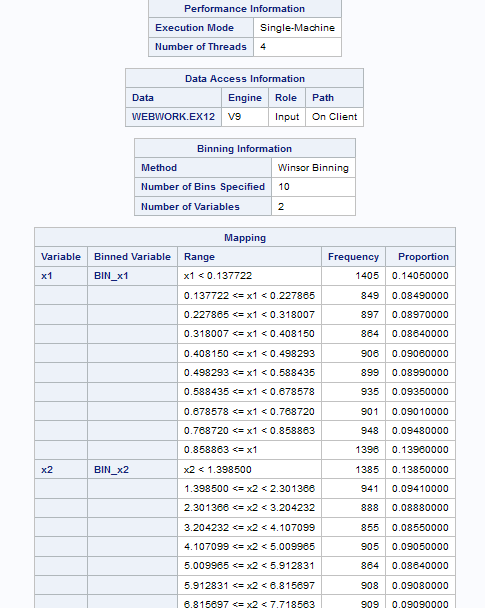Bin Continuous Data Task
About the Bin Continuous Data Task
The Bin Continuous Data task is a data preparation task. This task divides the data values of a continuous variable into intervals and replaces the values for each interval with a single value that
is representative of the interval.
Note: This task is available only
if you are running SAS 9.4 or later and if you have SAS/STAT.
Example: Winsorized Binning
In this example, the
task provides the basic Winsorized statistical information for the
input data.
To create this example:
-
To create the Work.Ex12 data set, enter this code into a Program tab:
data ex12; length id 8; do id=1 to 10000; x1 = ranuni(101); x2 = 10*ranuni(201); x3 = 100*ranuni(301); output; end; run;Click .
.
Assigning Data to Roles
To run the Bin Continuous
Data task, you must assign a variable to the Variables
to bin role.
|
Role
|
Description
|
|---|---|
|
Roles
|
|
|
Variables
to bin
|
specifies one or more
variables as input variables for binning. The specified variables
must be interval variables.
|
|
Additional Roles
|
|
|
Frequency
count
|
specifies a numeric variable that contains the frequency of occurrence for each observation. If the frequency value is less than 1 or is missing, the observation is not used
in the analysis. If no variable is assigned to the Frequency
count role, each observation is assigned a frequency
of 1.
|
Setting Options
|
Option Name
|
Description
|
|---|---|
|
Methods
|
|
|
Number of
bins
|
specifies the global number of binning levels for all binning variables. This value
can be any integer between 2 and 1,000, inclusive. The default number of binning levels is 16.
|
|
Method
|
specifies which binning
method to use.
|
|
Statistics
|
|
|
Select statistics
to display
|
In the results, you
can specify whether to include statistics.
Here are the additional
statistics that you can include:
|
Creating an Output Data Set
You can specify whether to save the results to an output data set. In the Additional
variables to include in the output data set role, specify any columns from the input data set that you want to include in the output data set.
To view all or a subset of the output data set in the results, select Show output
data.
Copyright © SAS Institute Inc. All rights reserved.
